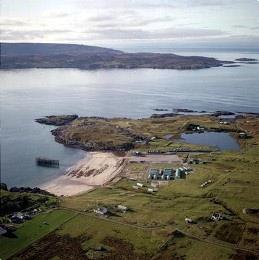Coastal Monitoring Site: Loch Ewe
Multiple parameters have been measured at Loch Ewe since 2000 however temperature measurements have been recorded since 1999. This site acts as a reference site to fulfill the requirements of the EU Water Framework Directive and the EU Marine Strategy Framework Directive. The input of Jane and Willie Grant into the success of the monitoring programme is gratefully acknowledged.
Loch Ewe is a sea loch on the west coast of Scotland. The loch has a narrow entrance and is sheltered from the worst of Atlantic storms by the Hebrides Island chain. The coastline outside of Loch Ewe is exposed in a northward direction to the North Atlantic. Loch Ewe has a volume of 945 x 106 m3 making it one of the larger sea lochs in Scotland by volume. It is relatively shallow for a Scottish sea loch and has a round shape, only 11 km long, giving it a low aspect ratio (length to width). The loch faces north and has variable exchange with the North Minch, which is influenced by influxes of Atlantic water. There is some riverine influence with 9% of the flow in the loch coming from freshwater (Edwards and Sharples, 1986).
The Loch Ewe monitoring site is 40 m in depth and located in the outer basin of the loch, which has a maximum depth of 62 m and a sill depth of 33 m. As the water sampling site is close to the northerly opening of the sea loch, this is an exposed site. Since April 2002 temperature, salinity, nutrients, chlorophyll ‘a’, phytoplankton and zooplankton have been sampled weekly from a small boat near the mouth of the loch, initially operated by MSS staff and latterly by Isle of Ewe Shellfish. The minilogger is positioned further into the loch at a sheltered site, attached to a mooring. Due to its position in the loch, the minilogger site is likely to be influenced more by fresh water flowing into the loch. During the winter this water is colder than the surrounding loch water and during the summer this water is warmer than the surrounding loch water. The SPATT bag for algal toxin analysis is located at this site and phytoplankton samples before 2002 were also collected here.


